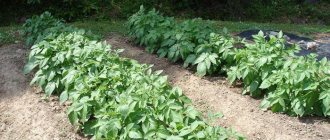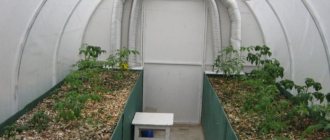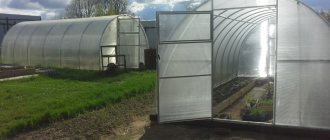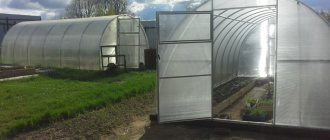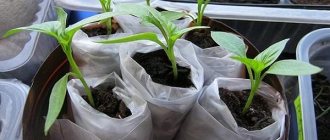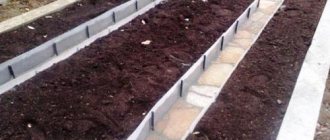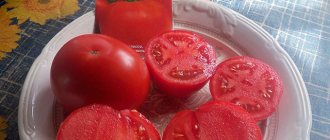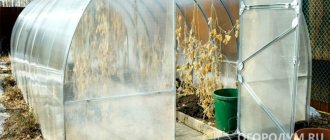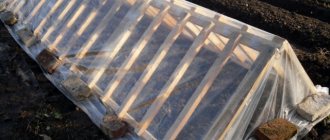Planting tomatoes according to Mittleider gives abundant harvests from a small area and ensures rapid growth of tomatoes. The author of the method is a scientist, an expert in agriculture, with a doctorate in agricultural sciences, American Jacob Mittleider (1918-2006).
His method of growing tomatoes combines hydroponics technology (growing crops on nutrient substrates, without natural soil) with traditional farming. In Russia, the technique has been popular for more than 25 years. Technology has its fans and detractors.
The essence of the Mittleider method
Technology is based on making full use of space, resources and time. Tomatoes are planted densely, providing them with additional nutrition, which makes it possible to increase yield.
Within the technology, there are 2 methods of planting plants.
- Growing vegetables in narrow beds. Used for growing vegetables in open ground.
- Cultivation in box-beds filled with artificial soil mixture. Used in greenhouses and areas with poor soils. The boxes are made of any size, but the depth should be 20-25 cm. At the bottom of the box there is natural soil, the top layer consists of an artificial fertile soil mixture. Boxes for greenhouses are usually made with a bottom, and for open ground only with side walls so that the roots can penetrate into the natural soil.
Reviews
Vladimir, Leningrad region.
“A long time ago, at the beginning of 2001, I read an article about narrow bulk boxes - beds and forgot about it. And in retirement they moved to live in the village, and the land near the house is clayey and infertile. That's when I remembered that article I read. There was a lot of sawdust from the construction of the bathhouse. He put together narrow boxes, filled them with sawdust, shavings, and pine needles from the forest and left them like that for the winter. In the spring I brought sand and a car of soil, filled it up, added fertilizer, mixed it and planted cabbage and potatoes. Only later did I find out that this method is called the Mittleider method. I still plant, but I add very little fertilizer and more organic matter.”
Irina, Kostroma
“The area near the house is very small, and I tried to compact the plantings as much as possible, but the vegetables grew small due to lack of sunlight and nutrition. But I read about narrow beds and for a long time did not dare to make them, and there were also the costs of buying boards. But, when once again we were left without a harvest, we dug up the entire garden and made narrow beds - boxes. Weeded weeds and leftovers from the kitchen were placed down, and a mixture of earth, sand, and compost was covered on top. There were much fewer beds, but at least two people could walk along the rows. I was very worried that the harvest would be small. I planted potatoes, tomatoes, cucumbers in 1 row, carrots, beets in 2 rows. I made borders on the sides as required, but reduced the amount of fertilizer by half, and watered it several times with infused grass and added ash. The soil between the plants was mulched with grass cut from the rows. The harvest was even a little larger than with normal planting. Each bush was in the sun and developed well. I will continue planting like this, but I will keep the amount of fertilizer to a minimum.”
Mitlider taught Russian gardeners to use every centimeter of space, which makes it possible for any plant to receive sufficient light, nutrition and moisture. Tomatoes develop fully even in a box on a balcony or windowsill. To produce a harvest, they need constant fractional feeding and watering. But each gardener decides whether or not to use such technology for cultivating vegetable crops in his garden independently.
Advantages and disadvantages of the method
Like any other method, planting tomatoes according to Mitlider has its pros and cons.
Advantages of planting using the 1st method in narrow beds:
- Increased yields. Tomatoes are supplied with additional nutrients, as in hydroponics. The difference between the method is that the roots have access to the minerals found in the ground.
- Rational use of space, time and labor resources. Material costs for growing tomatoes are kept to a minimum, the area of the beds is small, and the time and effort required to cultivate them is significantly reduced.
- Balanced plant nutrition. Mitlider has developed balanced fertilizers that include all the necessary elements for plants. The mixtures were formulated based on 35 years of testing and experimentation.
- Protection from cold, wind and snow. In emergency situations, narrow beds can be easily covered by constructing film shelters or mini-greenhouses.
- Economical use of water is especially important in dry years. Water is supplied only to the root system. The irrigation area is smaller than in classic beds.
Advantages of box beds:
- Productivity does not depend on the quality of local soils; boxes can be installed on any site.
- Requires a small area.
- The method provides balanced nutrition of tomatoes, good drainage and aeration of the roots.
- The soil in shallow boxes quickly warms up in the sun in the spring, lengthening the growing season.
- The soil in the boxes is loose and moist, which allows the roots of the tomatoes, after passing through a layer of artificial soil mixture, to reach the natural soil.
Disadvantages of the method:
- Wetlands, sandy areas and areas on slopes are not suitable for using narrow bed technology.
- In shaded gardens, the yield is reduced by 3-4 times.
- Forming beds is more difficult than with the usual method of growing tomatoes.
- It is difficult for novice amateur vegetable growers to correctly formulate fertilizers, since they contain many components.
What varieties of tomatoes can be grown according to Mittleider
Planting tomatoes according to Mittleider is applicable for growing determinate (with limited growth) and indeterminate (tall) varieties.
It is traditionally believed that in temperate climates, low-growing varieties can be grown in open and closed ground, and tall varieties can only be grown in greenhouses.
However, breeders have developed many modern early-ripening indeterminate varieties that grow well in open beds. Therefore, both methods 1 and 2 are suitable for growing low-growing and tall bushes.
Autobiography
A world-famous American scientist-breeder, born a hundred years ago, throughout his life he was engaged in developing new varieties of vegetables and flowers. Mittleider proposed a unique innovative technology for growing vegetables on small plots of land. Traveling to many countries, the scientist studied the growing conditions of plants in different climatic regions.
In 1975, he came up with the idea of making an original polycarbonate greenhouse structure. As well as the creation of raised symmetrical beds in which the crops grown had good immunity and increased yield.
Formation of beds
Site preparation includes the following steps.
- Before starting to form the beds, the area is leveled, hummocks and debris are removed.
- Dolomite flour is added to acidic soils. Gypsum is added to alkaline soil.
- Provide good water drainage. To do this, remove the top layer of soil, put 20-30 cm of bark and sawdust, then return the fertile layer to its place. In lowlands, the ground is raised by 20-25 cm.
- The rows are arranged strictly from north to south.
- The beds are formed at the same level as the row spacing, neither higher nor lower.
Structure of narrow ridges
According to Mitlider, narrow beds are 45 cm wide and 9 m long (the length can be changed). On the sides of the bed along the long side, earthen edges 10 cm high and wide are poured. The width of the inner part of the bed between the edges should be 30-35 cm. It is also advisable to make edges at the ends. The surface inside is carefully leveled.
With this formation, water does not flow into the rows and is completely used.
The distance between the beds is 105 cm. This is necessary for good illumination of the plants and sufficient space for their growth. In small areas, row spacing can be reduced to 75 cm when planting varieties with compact bushes.
A few more notes
Classic vegetable growing recommends crop rotation. In the case of tomatoes grown in a greenhouse, this is not always possible. What should I do? According to the experience of amateurs, it is possible to grow tomatoes for quite a long time in the same place (in one greenhouse), but at the same time perform a minimum set of operations. Some gardeners advise removing the roots of tomatoes and replacing the top, approximately 5 cm, layer of soil in the greenhouse. Others advise adding compost regularly. And of course, keep the greenhouse clean, wash (glass or polycarbonate), if necessary, not only the outside, but also the inside, paint with Pinotex or whitewash (if any) wooden supports.
Fertilizer application according to the Mittleider method
The scientist has developed 2 compositions for fertilizing beds and feeding crops during the growing season.
- Mixture No. 1 is used as a pre-planting fertilizer. Components of the first mixture: nitrophoska (450 g), lime, chalk or dolomite (900 g), borax (15 g).
- Mixture No. 2 is used before planting and for regular fertilizing of crops.
There are 2 variants of this fertilizer.
- Option 1. Urea or urea (1 kg), ammophos (600 g), calcium sulfate or chloride (1 kg), magnesium sulfate or bitter salt (450 g), lime or dolomite (400 g), boron and molybdenum (10 each G).
- Option 2. Ammonium nitrate (675g), calcium sulfate or chloride, lime and magnesium (450 g each), nitrophoska (2.7 kg), borax and molybdenum (10 g each).
Before planting the plants, the bed is fertilized with one of the mixtures, depending on the type of soil.
After applying fertilizers, the surface is dug up to a depth of 15-20 cm.
Boxes-ridges, before planting tomatoes in them, are filled with sand, sawdust, perlite, sphagnum moss, pine bark or other available materials. Use 3-4 components at a time. Add 2/3 of mixture No. 1 and 1/3 of mixture No. 2 to the box. Water the contents generously and mix well. Then they are leveled.
Russian interpretation
Living in California, Jacob Mittleider created a method of cultivation in ridges, starting from subtropical climatic conditions. In regions of Russia with a cold climate, to use the Mittleider method, the ridge boxes should be raised by 5cm-8cm, using a layer of fresh mullein and organic matter as a “heated pillow”.
Boxes-beds can be successfully placed on balconies, loggias and roofs of houses.
Sowing tomato seeds
- For sowing, choose large, strong seeds without black spots. Planting is carried out in boxes filled to the brim with loose nutritious soil.
- Add 2 tablespoons of lime and 15 g of potassium fertilizer and phosphate to the soil.
- Water the soil carefully to prevent a crust from forming.
- The seeds are planted in rows at least 5-7 cm apart at a depth of 1-1.5 cm, carefully sprinkled with soil and watered again.
- The box is covered with burlap or gauze to retain heat and moisture.
- As soon as the first sprout hatches, the burlap is removed and the container is moved to a sunny place.
- Before planting in a permanent place, the seedlings are watered from a watering can with a weak solution of fertilizer No. 2 (25 g of fertilizer is diluted in 10 liters of water).
When planting seeds in warm climates in open ground, make a shallow furrow along one of the sides, leaving the middle of the bed free. Plant the seeds individually at a distance of 20 cm from each other.
Planting seedlings
Tomato seedlings are planted in a permanent place when they grow 15-30 cm in height (depending on the variety). The sprouts are placed along one side in rows at a distance of 20 cm from each other. The bushes are planted in holes with a large lump of earth, deepening the plants so that at least half of the stem remains on the surface.
Before planting in a permanent place, the sprouts are watered abundantly. For better survival in a new place, seedlings are watered with nitrogen fertilizer dissolved in water. To prevent tall plants from shading small ones, they are placed on the north side of the bed, giving small plants more light.
In the video, the gardener explains the principle by which tomatoes planted using the Mittleider method grow in a greenhouse.
What are the benefits for plants?
- In the “American” greenhouse, tomatoes, peppers and eggplants do not overheat even at high temperatures, without additional costs and equipment (fans, electrical energy). This is achieved thanks to natural ventilation.
- Plants are not afraid of mold and fungi: there is no condensation in the greenhouse according to Mittleider.
- The greenhouse is installed so that the transom and side windows “look” to the south. Thanks to this, cold northern winds will never get inside the structure. The large volume of the greenhouse creates a special microclimate and allows you to build several narrow beds - this way the plants will not be crowded and “take away” light, water, fresh air and nutrients from each other.
Stages of tomato care
- Watering should be regular so that the soil in the garden bed is constantly moist.
- Plants are watered only at the roots, since many weeds grow when irrigated by sprinkling.
- The garter is carried out when the bushes have reached a height of 40 cm.
2 fishing lines are stretched along the sides of the bed, to which each plant is tied with an individual cord in a checkerboard pattern. The first tomato to the right line, the next to the left line. This way the bushes will be better illuminated. The lower end of the cord is tied to the stem near the ground with a knot so that a free loop remains.
As the stem grows, it may thicken; it is important that the node does not interfere with its growth. The bush is wrapped around a rope, and when the plant reaches the wire, the top is pinched.
- To prevent plants from shading each other, some of the leaves are torn off.
First of all, get rid of the lower leaves and part of the side branches. In tall varieties, shoots are removed, forming bushes with 1 stem. In low-growing varieties, shoots are usually left behind.
- The use of pesticides and nitrates is completely abandoned.
Regular watering, proper nutrition and the natural process of photosynthesis allow tomatoes to independently regulate life processes in the ecosystem.
- Seedlings are fed 6-8 times per season with fertilizer No. 2 diluted in water.
- When tomatoes are affected by diseases, remove diseased leaves and fruits to prevent the spread of infection.
To prevent fungal diseases, with the onset of cold nights, treatment is carried out with foundationazole, ridomil or Bordeaux mixture. Treatment cannot be carried out during the fruiting period.
From the forum:
Sergey VB, Sverdlovsk region: In my narrow beds, the tomato roots were washed with water and formed a net on the surface. I’m tempted to add more soil, but I’m afraid to break the technology. I water it often, so the surface layer almost never dries out. What do you advise? Maybe mulch? I only have sawdust.
vk, Moscow: I don’t think that by doing this you will violate the technology. But tomatoes are still unique plants - for example, it seems to me that before flowering you can skip feeding so that they do not fatten, and then continue. Observation is your main advisor. And one more thing: it seems to me that tomatoes react very strongly to the slightest shading.
Sergey VB, Sverdlovsk region: By mulching, you can also level the bed - after watering, puddles form in some places - so I mulch them thicker, and where the roots are washed, thinner. This way you can slowly level the bed perfectly. Making the bed horizontal is the hardest task for me from Mithlander. In terms of shading - which of the neighbors I won’t look at - it’s terrible in the greenhouses! The tomatoes are planted very densely; in the same area I have 35 roots; they have up to a hundred! One has a greenhouse roof made of boards and the side frame is made of reinforced film (it’s very convenient to say, you don’t have to cover the greenhouse every year)!, the other made a rack under the roof of the greenhouse, also from boards, and stores gardening tools there! There is a greenhouse made of brown plastic bottles!!! sewn. In response to my timid comments like it’s a little dark here, he says: How dark? Everything is seen! And they all always had heaps of tomatoes in past years. I don’t appear yet because the new methodology can only be assessed by the harvest. :)))
vk, Moscow: of course, the harvest is an indicator of the correctness of the technology. But not all reasons can be of equal value: this means that the benefits of some of your neighbors’ techniques outweigh the harm from their mistakes. By the way, plants need red-brown light; they absorb it, while green light is largely reflected due to the lower need.
And I consider the Mittleider method as some standard method, following which you can get a good or good harvest. But then, as your experience grows, you will make deviations from this standard in order to create optimal conditions for each specific crop, as soon as possible in your conditions.
Sergey VB, Sverdlovsk region: Well, everything is growing and new questions are arising. When tomatoes are overloaded with fruit, it is recommended to additionally fertilize with magnesium sulfate. Should I do this feeding once? And how to determine the mass filling I now have on each bush 5-6 tomatoes with a diameter of a 1-5 ruble coin. Lots more color. Is it time to feed with magnesium?
vk, Moscow: Magnesium for tomatoes, I think it’s early. The lower leaves will be spotted, this is normal, magnesium is drawn from them for reuse in new leaves and fruits.
Mikhail, Moscow: Belated comment about tomatoes. Indeed, it has been a tomato year in the Moscow region. I have 6 bushes in a 6 meter bed in my greenhouse. Those. There is enough space, light and air for the bushes. The usual care: gartering, pinching, pinching the tops in early August. Varieties Siberian Early and Beta Lux. We harvested so many tomatoes in August that we could at least sell them! :))The most amazing thing is that half of the harvest ripened on the bushes. In my opinion, for our latitudes this is an outstanding result. Due to busyness, laziness and forgetfulness, I did not spray the bushes with anything this year. However, late blight was not observed. Thanks to the neighbors who stopped experimenting with potatoes. And the weather, of course. I spent the second half of August fishing in the Astrakhan region, leaving the farm to my mother-in-law. On the phone I ask: Should I bring Astrakhan tomatoes? And the mother-in-law screams with horror in her voice, “Don’t you dare.” He returned and was stupefied. All the window sills in the house are strewn with ripening fruits. The same amount was given to neighbors, eaten and preserved. In total, according to my estimates, it turned out to be about 20 kg. Those. more than 3 kg per bush. Believe it or not, but the mother-in-law is a witness.
vk, Moscow: Mikhail, my tomatoes are still growing on the bushes - we remove the brown ones every week. Water - I don't water. The transom and door are always open. Good weather in August and early September and the absence of nearby potato fields as a spreader of infection stopped late blight and other infections. Although I still removed four bushes, the trunk was damaged. Now the foliage is practically not affected. It is curious that after severe pruning (until the bush was transparent), the foliage of the tomatoes very quickly restored to the required area!
PS why window sills? Tomatoes ripen better in the dark, in boxes.
Shtyrlitz, Minsk: By the way, tomatoes grow in open ground no worse than just a little more fiddling with them - but they grow well.
It is necessary to apply agricultural technology according to the climate zone. I noticed that the sowing dates for seeds are calculated according to the same as for the Non-Black Earth Region. Probably it is necessary to adjust it 2 weeks earlier. I carry out hardening from the moment the temperature reaches +10C and then outside around the clock. And spraying with peat oxidate. When planting, do not forget to treat the soil with Bordeaux and (then treat) periodically. This allows you to be saved. And if possible, plant them in the ground under film early, while there is a threat of frost. I survived down to -3C without shelter, although I felt a little sick. I just missed the processing a little and got late blight, but the green harvest saved me. And the late blight devoured everything in the neighbors’ and many’s greenhouses.
vk, Moscow: Therefore, it seems to me that a summer resident should not grow tomatoes in open ground. And if they are grown by a more experienced summer resident, then use a greenhouse, there is actually a larger harvest and fewer treatments, because even 1 g of just copper sulfate causes very severe poisoning in humans.
anatoli_, Protvino Moscow. region: I absolutely agree about the evergreenness of tomatoes in open ground.
nadjas: I gave up tomatoes and peppers a long time ago.
sunnygarden.ru
